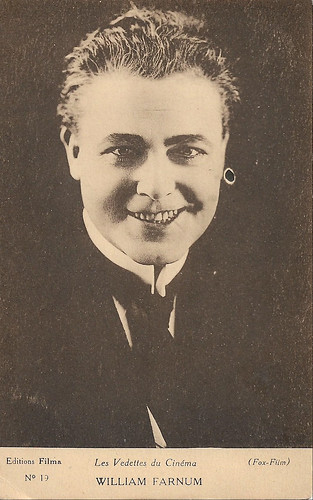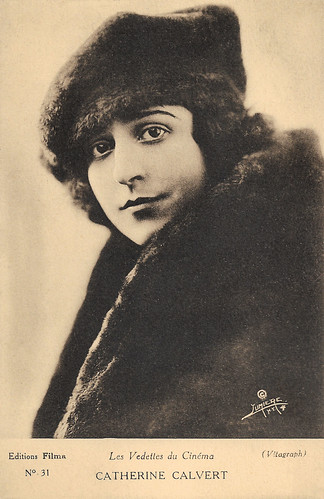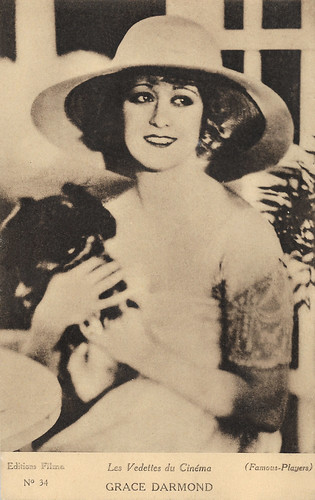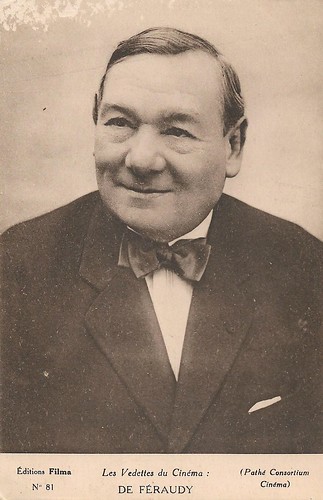Two years ago, EFSP did a post on the Les Vedettes du Cinéma series, published by the French publishing house Éditions Filma shortly after the First World War. Then we focused on the postcards with French 'vedettes'. Recently we acquired some new postcards of this vintage series, which is larger than we thought in 2017. Instead of the 70 cards we mentioned in the old post, the series contains at least 90 postcards. Today, 15 postcards with both European and American stars.

French postcard in the Les Vedettes du Cinéma series by Filma, no. 11. Photo: Evans, L.A. / Agence Générale Cinematographique.
Fannie Ward, a.k.a. Fanny Ward (1872–1952) was an American actress of stage and screen, known for The Cheat (1915), a sexually- and racially-charged silent film directed by Cecil B. DeMille. In the late 1910s, she did a series of films for Astra Films, released by Pathé Exchange.

French postcard in the Les Vedettes du Cinéma series by Filma, no. 19. Photo: Fox-Film.
American actor William Farnum (1876-1953) was one of the first major movie stars. From 1914 to 1925, Farnum was one of the biggest sensations in Hollywood, earning $10,000 a week. Farnum's silent pictures include the Westerns The Spoilers (1914) - which culminates in a spectacular saloon fistfight, Drag Harlan (1920) and the drama-adventure If I Were King (1921).

French postcard in the Les Vedettes du Cinéma series by Editions Filma, no. 24.
Georges Melchior (1889-1944) was a French film actor, active in French cinema between 1911 and 1937. He was known for the Fantômas serials (1913-1914) by Louis Feuillade, and L'Atlantide (1921).

French postcard in the Les Vedettes du Cinéma series by Editions Filma, no. 30. Photo: Fox-Film.
George Walsh (1889-1981) was an American film actor, who despite a successful career in silent cinema is best remembered for the part that was taken off from him: the title role in Ben-Hur (1925).

French postcard in the Les Vedettes du Cinéma series by Editions Filma, no. 31. Photo: Lumiere, New York / Vitagraph.
Catherine Calvert (1890–1971) was an American actress. After many years on the stage, and after the death in 1915 of her husband, the playwright Paul Armstrong, she made her film debut in the Universal film production Partners (Hobart Hanley, 1916). In the following years, she often worked under the direction of James Kirkwood for Frank A. Keeney Pictures, e.g. in A Romance of the Underworld (James Kirkwood, 1918). Around 1920 Calvert was a star of the Vitagraph Studios in films like Dead Men Tell No Tales (Tom Terriss, 1920). In 1923 she did her last film: Out to Win (James Kirkwood, 1923). In 1925 she married her second husband, millionnaire George Carrothers, a Canadian wheat exporter. All in all, she acted in 21 films.

French postcard in the Les Vedettes du Cinéma series by Editions Filma, no. 33. Photo: Films Pathé.
Dolores Cassinelli (1888-1984) was an American actress. She was dubbed 'The Cameo Girl of the Movies'. From 1911 to 1925, when she retired from the screens, Dolores Cassinelli acted in about eighty films.

French postcard in the Les Vedettes du Cinéma series by Editions Filma, no. 34. Photo: Famous Players.
Grace Darmond (1893-1963) was a Canadian-American actress of the silent screen. In 1918 or 1919 Darmond started to work in California at various studios, first at Famous Players for The Valley of the Giants (James Cruze, 1919), with Wallace Reid. Her performance as the seductress in the Thomas Ince production Below the Surface (Irvin Willat, 1920), alongside Hobart Bosworth and Lloyd Hughes as a deep-sea diver and his son, earned her in 1921 the chance to play opposite Boris Karloff (his first feature part) in the serial The Hope Diamond Mystery (dir. Stuart Paton).

French postcard in the Les Vedettes du Cinéma series by Editions Filma, no. 38. Photo: Vitagraph.
Alice Joyce (1890-1955) was an American screen actress, who, at the peak of her career, was nicknamed 'the Madonna of the Screen'.

French postcard in the Les Vedettes du Cinéma series by Editions Filma, no. 41. Photo: John Hill / Films Pathé.
American actress and dancer Mae Murray (1885-1965) had her breakthrough on Broadway at the Ziegfeld Follies. Her film debut was in To Have and to Hold (1916). Murray became one of the biggest stars of Universal, often directed by her then-husband, Robert Z. Leonard. At the height of her career, she decided to found her own company with director John Stahl. While the films were successful, critics didn’t like them, because of her exaggerated emotions and her costumes. In the early 1920s, Murray started acting at Metro (later MGM). Murray’s most famous role was that in Erich Von Stroheim’s The Merry Widow (1925), co-starring John Gilbert.

French postcard in the Les Vedettes du Cinéma series by Editions Filma, no. 49. Photo: Vitagraph.
William Duncan (1879–1961), born in Dundee, Scotland was an actor, writer, and director of films and film serials, often Westerns. He was a leading star, becoming one of the highest-paid actors in the early film industry, though many of his films do not survive. Duncan, who was Hollywood's first Scottish movie star, worked with the major studios of the day including the Selig Polyscope Company and Vitagraph.

French postcard in the Les Vedettes du Cinéma series by Editions Filma, no. 59. Photo: Agence Générale Cinématographique.
Monroe Salisbury (1876-1935) was an American stage and screen actor, who peaked on screen in the late 1910s and early 1920s, often in Westerns.

French postcard in the Les Vedettes du Cinéma series by Filma, no. 63. Photo: Agence Générale Cinématographique.
Though no details are known about the life dates and private life of French actress Tania Daleyme, she is famous for her lead in one film by Germaine Dulac, La belle dame sans merci (1920), while she had a supporting role as a bar maid in Dulac's experimental film L'invitation au voyage (1927). She also had supporting parts in Simplette (René Hervil, 1919), Tristan et Yseult (Maurice Mariaud, 1920), Le coeur magnifique (Jean Legrand, Séverin-Mars, 1921), Le double (Alexander Ryder, 1923), and Titi premier, roi des gosses (René Leprince, 1926).

French postcard in the Les Vedettes du Cinéma series by Editions Filma, no. 65. Photo: Paramount Artcraft Pictures.
Elsie Ferguson (1885–1961) was an American stage and film actress. She first climbed up to become a big Broadway star thanks to producers such as Charles Frohman and Henry B. Harris, who both perished in the sinking of resp. the Lusitania and the Titanic. After her Broadway career, she had a fertile career in the silent cinema, from 1917 till 1922. She debuted in Maurice Tourneur's Barbary Sheep (1917). Playing often elegant society women, but also because of her arrogant behaviour, she was nicknamed 'the Aristocrat of the Screen'.

French postcard in the Les Vedettes du Cinéma series by Editions Filma, no. 81. Photo: Pathé Consortium Cinéma.
Maurice de Féraudy (1859-1932) was an actor of the Comédie-Française and a French director. He was also a notable actor and director in the French silent cinema. One of his most remarkable parts was that of the title role in the realist drama Crainquebille/Bill/Old Bill of Paris (Jacques Feyder, 1922).

French postcard in the Les Vedettes du Cinéma series by Filma, no. 90. Photo: Pathé Consortium Cinéma.
Andrew Brunelle (1894-1943) was a French screen actor of the silent and sound era. He played Dr. Howey in Louis Feuillade's serial La nouvelle mission de Judex (1917), starring René Cresté as Judex. Brunelle played an evil doctor, member of the dangerous gang La rafle aux secrets (the raiders of the secrets), who avid to steal and resell important technological inventions.

French postcard in the Les Vedettes du Cinéma series by Filma, no. 11. Photo: Evans, L.A. / Agence Générale Cinematographique.
Fannie Ward, a.k.a. Fanny Ward (1872–1952) was an American actress of stage and screen, known for The Cheat (1915), a sexually- and racially-charged silent film directed by Cecil B. DeMille. In the late 1910s, she did a series of films for Astra Films, released by Pathé Exchange.

French postcard in the Les Vedettes du Cinéma series by Filma, no. 19. Photo: Fox-Film.
American actor William Farnum (1876-1953) was one of the first major movie stars. From 1914 to 1925, Farnum was one of the biggest sensations in Hollywood, earning $10,000 a week. Farnum's silent pictures include the Westerns The Spoilers (1914) - which culminates in a spectacular saloon fistfight, Drag Harlan (1920) and the drama-adventure If I Were King (1921).

French postcard in the Les Vedettes du Cinéma series by Editions Filma, no. 24.
Georges Melchior (1889-1944) was a French film actor, active in French cinema between 1911 and 1937. He was known for the Fantômas serials (1913-1914) by Louis Feuillade, and L'Atlantide (1921).

French postcard in the Les Vedettes du Cinéma series by Editions Filma, no. 30. Photo: Fox-Film.
George Walsh (1889-1981) was an American film actor, who despite a successful career in silent cinema is best remembered for the part that was taken off from him: the title role in Ben-Hur (1925).

French postcard in the Les Vedettes du Cinéma series by Editions Filma, no. 31. Photo: Lumiere, New York / Vitagraph.
Catherine Calvert (1890–1971) was an American actress. After many years on the stage, and after the death in 1915 of her husband, the playwright Paul Armstrong, she made her film debut in the Universal film production Partners (Hobart Hanley, 1916). In the following years, she often worked under the direction of James Kirkwood for Frank A. Keeney Pictures, e.g. in A Romance of the Underworld (James Kirkwood, 1918). Around 1920 Calvert was a star of the Vitagraph Studios in films like Dead Men Tell No Tales (Tom Terriss, 1920). In 1923 she did her last film: Out to Win (James Kirkwood, 1923). In 1925 she married her second husband, millionnaire George Carrothers, a Canadian wheat exporter. All in all, she acted in 21 films.

French postcard in the Les Vedettes du Cinéma series by Editions Filma, no. 33. Photo: Films Pathé.
Dolores Cassinelli (1888-1984) was an American actress. She was dubbed 'The Cameo Girl of the Movies'. From 1911 to 1925, when she retired from the screens, Dolores Cassinelli acted in about eighty films.

French postcard in the Les Vedettes du Cinéma series by Editions Filma, no. 34. Photo: Famous Players.
Grace Darmond (1893-1963) was a Canadian-American actress of the silent screen. In 1918 or 1919 Darmond started to work in California at various studios, first at Famous Players for The Valley of the Giants (James Cruze, 1919), with Wallace Reid. Her performance as the seductress in the Thomas Ince production Below the Surface (Irvin Willat, 1920), alongside Hobart Bosworth and Lloyd Hughes as a deep-sea diver and his son, earned her in 1921 the chance to play opposite Boris Karloff (his first feature part) in the serial The Hope Diamond Mystery (dir. Stuart Paton).

French postcard in the Les Vedettes du Cinéma series by Editions Filma, no. 38. Photo: Vitagraph.
Alice Joyce (1890-1955) was an American screen actress, who, at the peak of her career, was nicknamed 'the Madonna of the Screen'.

French postcard in the Les Vedettes du Cinéma series by Editions Filma, no. 41. Photo: John Hill / Films Pathé.
American actress and dancer Mae Murray (1885-1965) had her breakthrough on Broadway at the Ziegfeld Follies. Her film debut was in To Have and to Hold (1916). Murray became one of the biggest stars of Universal, often directed by her then-husband, Robert Z. Leonard. At the height of her career, she decided to found her own company with director John Stahl. While the films were successful, critics didn’t like them, because of her exaggerated emotions and her costumes. In the early 1920s, Murray started acting at Metro (later MGM). Murray’s most famous role was that in Erich Von Stroheim’s The Merry Widow (1925), co-starring John Gilbert.

French postcard in the Les Vedettes du Cinéma series by Editions Filma, no. 49. Photo: Vitagraph.
William Duncan (1879–1961), born in Dundee, Scotland was an actor, writer, and director of films and film serials, often Westerns. He was a leading star, becoming one of the highest-paid actors in the early film industry, though many of his films do not survive. Duncan, who was Hollywood's first Scottish movie star, worked with the major studios of the day including the Selig Polyscope Company and Vitagraph.

French postcard in the Les Vedettes du Cinéma series by Editions Filma, no. 59. Photo: Agence Générale Cinématographique.
Monroe Salisbury (1876-1935) was an American stage and screen actor, who peaked on screen in the late 1910s and early 1920s, often in Westerns.

French postcard in the Les Vedettes du Cinéma series by Filma, no. 63. Photo: Agence Générale Cinématographique.
Though no details are known about the life dates and private life of French actress Tania Daleyme, she is famous for her lead in one film by Germaine Dulac, La belle dame sans merci (1920), while she had a supporting role as a bar maid in Dulac's experimental film L'invitation au voyage (1927). She also had supporting parts in Simplette (René Hervil, 1919), Tristan et Yseult (Maurice Mariaud, 1920), Le coeur magnifique (Jean Legrand, Séverin-Mars, 1921), Le double (Alexander Ryder, 1923), and Titi premier, roi des gosses (René Leprince, 1926).

French postcard in the Les Vedettes du Cinéma series by Editions Filma, no. 65. Photo: Paramount Artcraft Pictures.
Elsie Ferguson (1885–1961) was an American stage and film actress. She first climbed up to become a big Broadway star thanks to producers such as Charles Frohman and Henry B. Harris, who both perished in the sinking of resp. the Lusitania and the Titanic. After her Broadway career, she had a fertile career in the silent cinema, from 1917 till 1922. She debuted in Maurice Tourneur's Barbary Sheep (1917). Playing often elegant society women, but also because of her arrogant behaviour, she was nicknamed 'the Aristocrat of the Screen'.

French postcard in the Les Vedettes du Cinéma series by Editions Filma, no. 81. Photo: Pathé Consortium Cinéma.
Maurice de Féraudy (1859-1932) was an actor of the Comédie-Française and a French director. He was also a notable actor and director in the French silent cinema. One of his most remarkable parts was that of the title role in the realist drama Crainquebille/Bill/Old Bill of Paris (Jacques Feyder, 1922).

French postcard in the Les Vedettes du Cinéma series by Filma, no. 90. Photo: Pathé Consortium Cinéma.
Andrew Brunelle (1894-1943) was a French screen actor of the silent and sound era. He played Dr. Howey in Louis Feuillade's serial La nouvelle mission de Judex (1917), starring René Cresté as Judex. Brunelle played an evil doctor, member of the dangerous gang La rafle aux secrets (the raiders of the secrets), who avid to steal and resell important technological inventions.
No comments:
Post a Comment